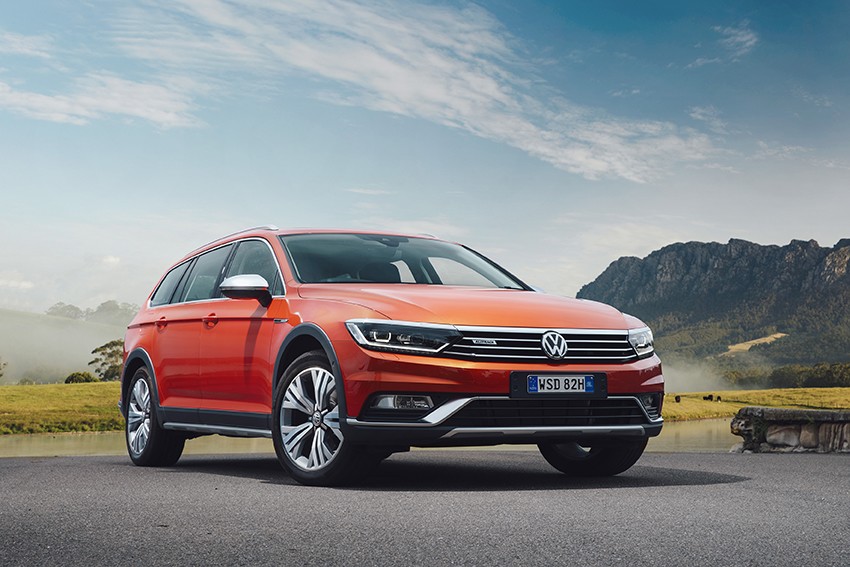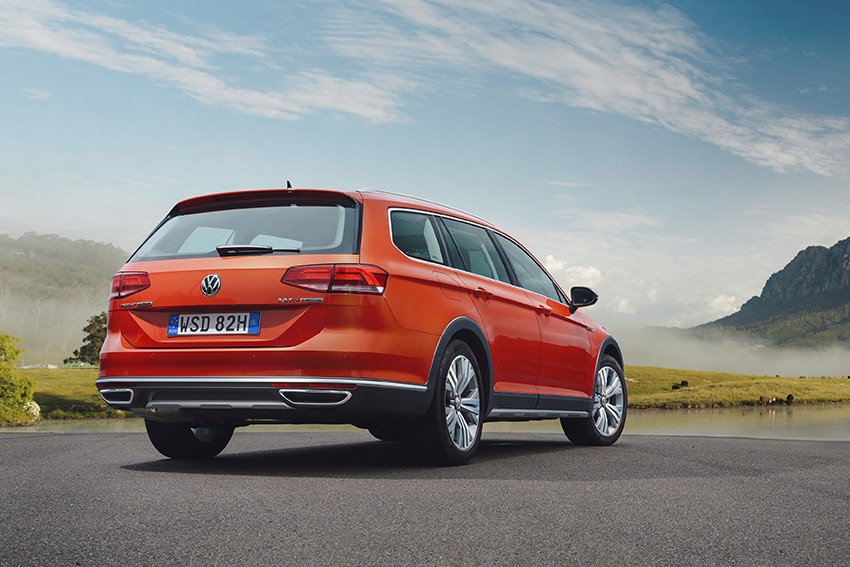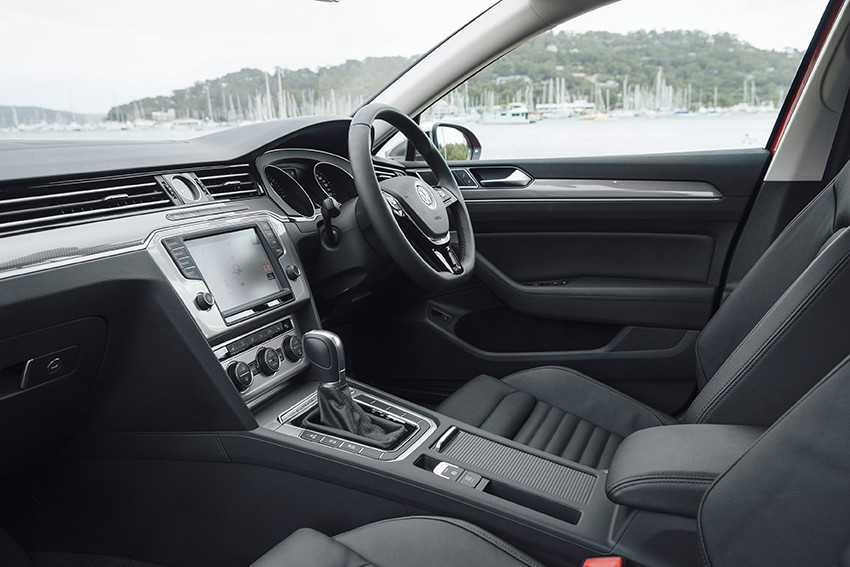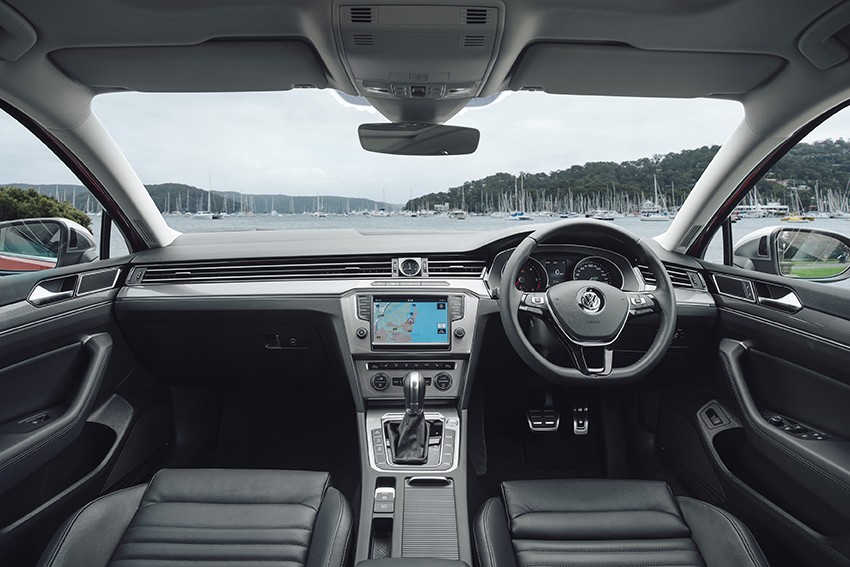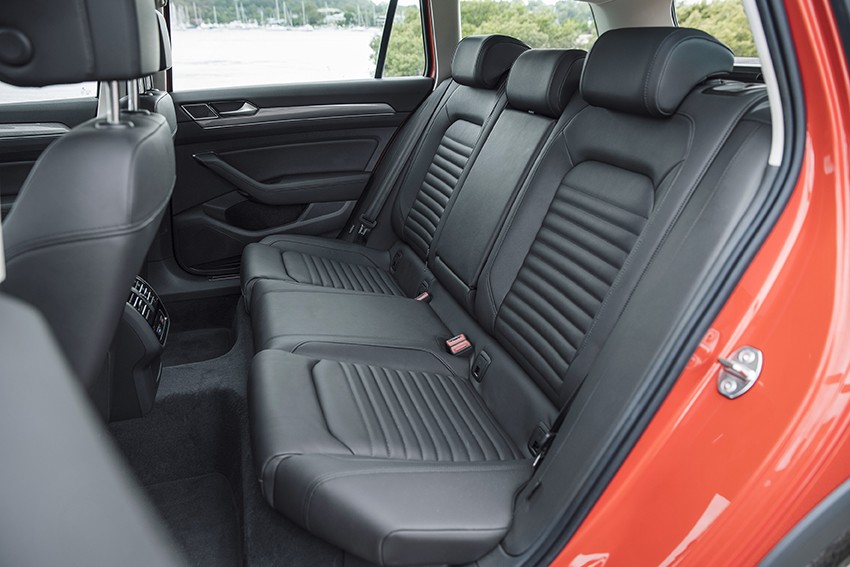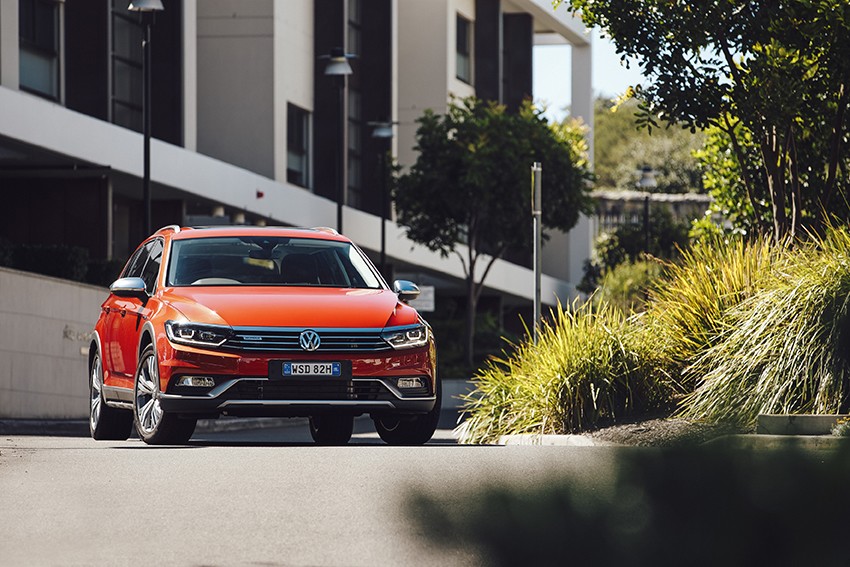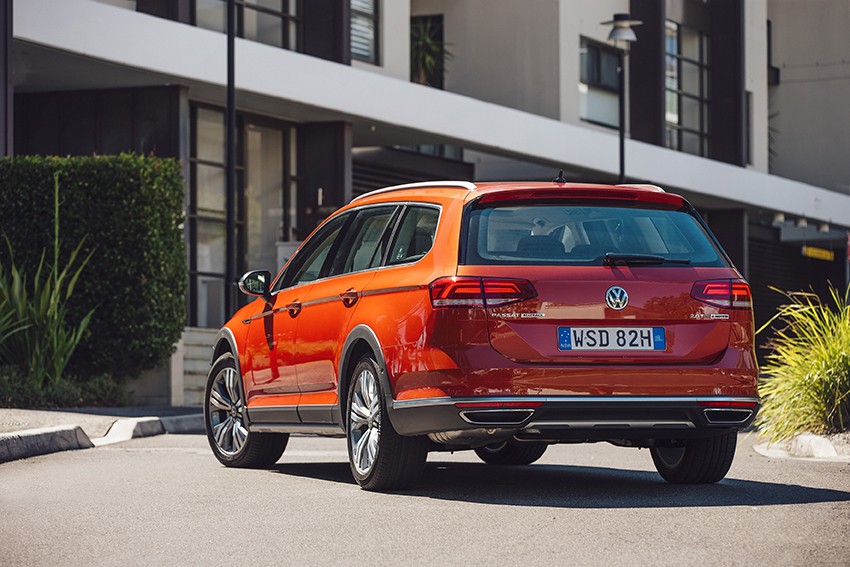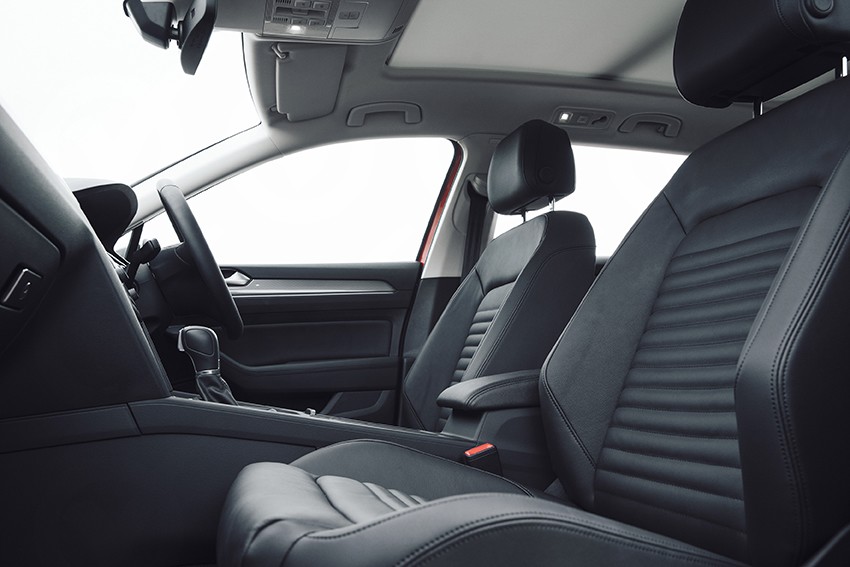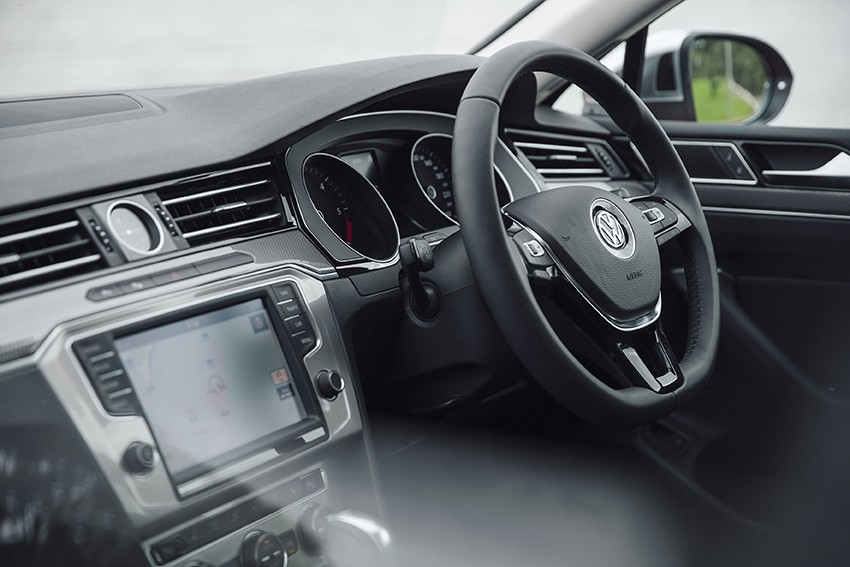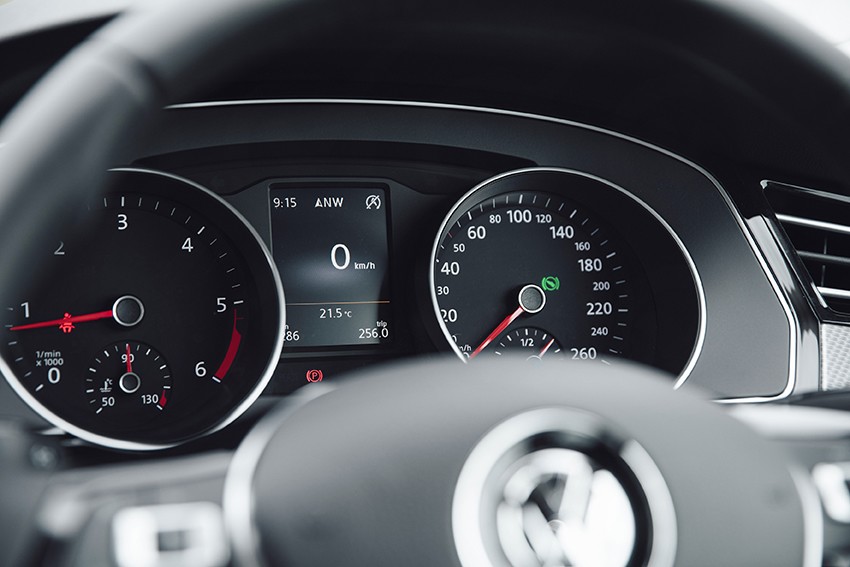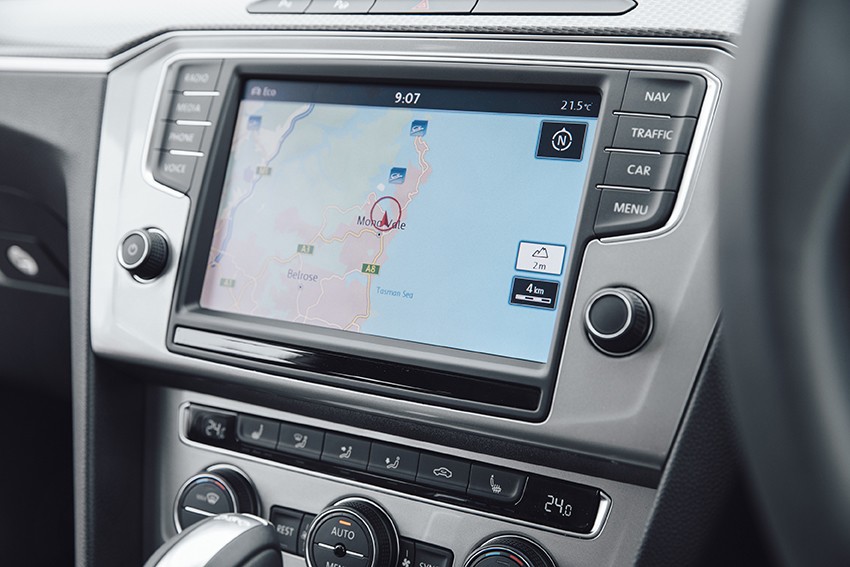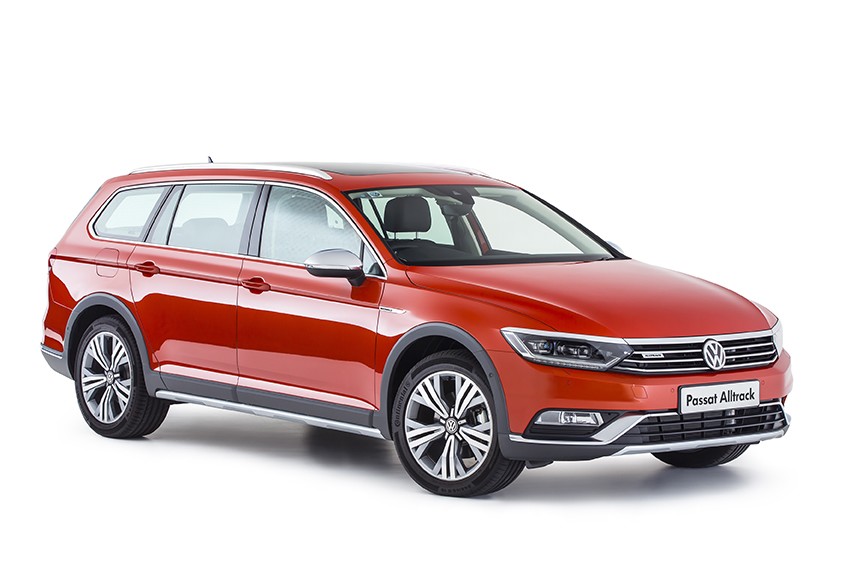
- Fuel-efficient turbo-diesel engine
- High standard of interior fit and finish
- Active safety technologies
- Lots of luggage space
- Generally comfortable ride…
- … but low-speed ride is slightly lacking in compliance
- Light steering lacks feedback
- Driving experience fails to engage the driver
- Tyre noise on coarse surfaces
Review: Volkswagen B8 Passat Alltrack (2016-18)
Overview
Released in Australia in February 2016, the Volkswagen Mk.7 Passat Alltrack was a mid-size, all-wheel drive wagon. Manufactured in Germany, the Volkswagen B8 Passat Alltrack was powered by a 2.0-litre turbo-diesel engine that was mated to a six-speed double clutch transmission. Although based on the B8 Passat wagon, the B8 Passat Alltrack had a Haldex all-wheel drive system and increased ground clearance.
To reduce fuel consumption, the DFCA engine had a Start/Stop function that enabled it to shut down the Passat Alltrack was stationary in traffic. Over the combined ADR 81/02 test cycle, fuel consumption for the B8 Passat Alltrack was 5.4 litres per 100 km.
| Variant | Engine | Trans. | Peak power | Peak torque | |
|---|---|---|---|---|---|
| Passat Alltrack | 140TDI | 2.0-litre DFCA turbo-diesel I4 | 6sp DCT | 140 kW at 3500-4000 rpm | 400 Nm at 1750-3000 rpm |
4MOTION all-wheel drive system
The Volkswagen B8 Passat Alltrack had a fifth generation Haldex (‘Haldex GenV’) coupling which utilised a wet multi-plate clutch. Since operation of the coupling was independent of the front and rear axle speeds, full locking torque could be applied at any given time and speed via an electrical pump that compressed the disc package. When coasting or with low engine loads, the clutch could disengage to direct all engine torque to the front axle and minimise fuel consumption. In traction/high slip conditions, however, the clutch could engage to direct up to 50 per cent of the engine’s torque to the rear axle (i.e. a 50:50 front:rear torque split).
For the Passat Alltrack, both the front and rear axles were fitted with electronic differential locks (Volkswagen’s ‘XDL’) that could brake a spinning wheel to transfer torque to the opposing wheel on that axle.
Body and dimensions
The Volkswagen B8 Passat was underpinned by Volkswagen’s Modular Transverse Matrix (MQB). Like the B8 Passat wagon , the Passat Alltrack is understood to have body rigidity of 25,000 Nm/degree.
Compared to the B7 Passat Alltrack , the B8 Passat Alltrack was 6 mm longer (at 4777 mm), 12 mm wider (1832 mm), 44 mm lower (1505 mm) and had an 80 mm longer wheelbase (2791 mm); ground clearance was 174 mm (27.5 mm greater than the B8 Passat ). The Volkswagen B8 Passat Alltrack had luggage capacity of 639 litres with the rear seats in position, though this increased to 1769 litres when the rear seats were folded flat.
Suspension
The Volkswagen B8 Passat Alltrack had MacPherson strut front suspension with lower wishbones, coil springs and an anti-roll bar. The independent, four-link rear suspension also utilised coil springs and an anti-roll bar.
Steering
The Volkswagen B8 Passat Alltrack had rack-and-pinion steering with electric power assistance; its turning circle was 11.4 metres.
Safety equipment
Standard safety equipment for the Volkswagen B8 Passat Alltrack included dual front airbags, a driver’s knee airbag, front and rear side airbags, full-length curtain airbags (i.e. for front and rear occupants), ABS, electronic stability control, traction control, front and outer rear seatbelts with pre-tensioners and front seatbelt load limiters.
As standard, the Passat Alltrack was also equipped with:
- Front Assist: used a radar sensor to detect if the vehicle was closing too fast on the vehicle ahead. If this occurred, Front Assist 1) provided audible and visual warnings to the driver, 2) brought the brake pads into contact with the brake discs for an emergency stop; and, 3) provided a jolting brake application to alert the driver. If the driver failed to respond, Front Assist would apply the brakes automatically to avoid or reduce the severity a collision;
- City Emergency Brake: an extension of Front Assist, City Emergency Braking operated at speeds up to 65 km/h and used a radar sensor and front camera to monitor the area ahead for vehicles and pedestrians. If a collision was anticipated, the driver was alerted via visual and audible warnings, followed by jolting brake application. If the driver failed to respond, the system would initiate emergency braking;
- Adaptive Cruise Control (ACC): using a radar sensor, ACC could maintain a pre-set distance to the vehicle ahead (including autonomous braking) and cause the vehicle to accelerate to its pre-set speed after braking;
- Rear Traffic Alert: when the driver was attempting to reverse out of a parking space, the Rear Traffic Alert system used radar sensors in the rear bumper to detect traffic up to 50 metres away that may cross the vehicle’s intended path. If a collision was considered imminent, Rear Traffic Alert would provide a visual warning, followed by an audible warning. If the driver did not respond to the warnings and there was an immediate collision risk, Rear Traffic Alert would automatically apply the brakes;
- Lane Assist (lane departure warning): using a camera to recognise lane markings, Lane Assist could detect unintentional lane drifting or changing and provide corrective steering actions for up to eight seconds. If the corrective steering actions were insufficient, the driver would be warned via steering wheel vibrations;
- Side Assist (lane change assistant): operated at speeds above 60 km/h and used two radar sensors in the rear bumper to monitor the area up to 70 metres behind the vehicle. If a vehicle was detected approaching from the rear or alongside the Passat, the driver was warned by illumination of an LED in the door mirror housing. If the driver then activated the turn indicator in the direction of the detected vehicle, the Side Assist indicator flashed to draw the driver’s attention to the mirror. If the driver attempted to steer into that area, the Lane Assist system would provide a counter-steering action to prevent the lane change; and,
- Driver Fatigue Detection: operating at speeds over 65 km/h, Driver Fatigue Detection monitored steering wheel movements for signs of fatigue. If detected, the driver would receive a warning in the multi-function display and an acoustic signal. The warning would be repeated after 15 minutes if the driver had not taken a break.
Euro NCAP testing
In Euro NCAP testing , the 2014 Volkswagen Mk.7 Passat 2.0 TDI Comfortline received a five star safety rating which included an 85 per cent adult occupant protection rating and an 87 per cent child occupant protection rating. In the offset crash test, protection of the driver’s head, thighs and feet were rated as good, though chest and lower leg protection were rated as adequate (i.e. a slight risk of serious injury); protection of the front passenger was rated as good in all areas. In the side impact test, protection of all areas was rated as good. In the more severe pole test, however, protection of the driver’s chest and abdomen were rated as adequate.
Under ANCAP’s methodology , this testing resulted in a five star adult occupant protection rating with a score of 35.89 out of 37.
Features: B8 Passat Alltrack
As standard, the Volkswagen B8 Passat Alltrack was fitted with Volkswagen’s ‘Discover Pro’ audio and navigation system which included an eight-inch colour touch screen, eight speakers, CD player, two SD card slots for music, 10 GB internal storage, 2D and 3D maps, MP3/WMA/AAC compatibility, jpeg image viewer, auxiliary 3.5 mm and USB inputs, Bluetooth mobile phone connectivity and audio streaming, and voice operation. Furthermore, the Passat Alltrack had an ‘App-Connect’ USB interface for Apple CarPlay, Android Auto and MirrorLink.
Other standard features for the B8 Passat Alltrack included 18 x 8.0J ‘Kalamata’ alloy wheels with 245/45 R18 Continental ‘ContiSeal’ (i.e. run-flat) tyres, black ‘Vienna’ leather appointed seat upholstery, ‘Comfort’ front seats, a power adjustable driver’s seat, heated front seats, three-zone climate control air conditioning, cruise control, front fog lights with static cornering lights, daytime driving lights, a rear fog lamp, dusk-sensing headlights, rain-sensing wipers, front and rear parking sensors, rear view camera with dynamic guidelines, 40/20/40 split and flat folding rear seats, a leather-wrapped steering wheel and gearshift lever, remote central locking with proximity key (i.e. keyless entry), power adjustable and heated door mirrors, power windows, a height and reach adjustable steering wheel adjustment, height adjustable front seats, auto-dimming rear view mirror, push-button start, three 12 volt power sockets (centre console, rear seat area and luggage compartment), illuminated vanity mirrors, tyre pressure monitoring, floor mats, tinted glass, chrome roof rails, an alarm and immobiliser.
The Passat Alltrack was also equipped with Volkswagen’s ‘Driving Profile Selection’ which enabled the driver to select from Normal, Sport, Eco and Individual drive modes which adjusted accelerator pedal response, engine mapping, power steering assistance, transmission behaviour and air conditioning output.
As standard, the Passat Alltrack was fitted with a full-size spare alloy wheel.
August 2016 update (MY17 changes)
In August 2016, standard features for the Volkswagen Passat Alltrack were extended to include fourteen-way power adjustable front seats, a massage function for the driver’s seat, memory function for the driver’s seat and door mirrors, power folding door mirrors, an auto-dimming driver’s side door mirror and kerb view function for the passenger side door mirror. Furthermore, the Passat Alltrack was fitted with Volkswagen’s ‘Air Care’ dual zone climate control air conditioning system which included an air cleaning function and allergen filter.
2017 Volkswagen Passat Alltrack 140TDI Wolfsburg Edition
The Volkswagen Passat Alltrack 140TDI Wolfsburg Edition was released in Australia in January 2017. Visually, the Passat Alltrack Wolfsburg Edition could be identified by its 8.0J x 19-inch ‘Albertville’ alloy wheels with 245/40 R19 tyres, LED headlights, rear privacy glass and ‘Wolfsburg’ badging. Inside, standard features for the Wolfsburg Edition were extended to include a 12.3-inch digital instrument cluster (Volkswagen’s ‘Active Info Display’), Nappa leather seat upholstery, steering wheel gearshift paddles, aluminium inserts for the dashboard and doors, piano black centre console trim, LED ambient interior lighting and black headliner.
As standard, the Passat Alltrack Wolfsburg Edition was fitted with ‘Adaptive Chassis Control’ which consisted of electronically-controlled dampers; the driver could also select from Normal, Sport or Comfort suspension settings.
The Volkswagen Passat Alltrack Wolfsburg Edition was available in white, metallic grey or Crimson Red paint finishes, the latter being unique to the Passat Alltrack Wolfsburg Edition. Australian-deliveries of the Passat Alltrack Wolfsburg Edition were limited to 250 vehicles.
The Volkswagen Passat Alltrack 140TDI Wolfsburg Edition returned to Australia in August 2017. Compared to the earlier Passat Alltrack Wolfsburg Editions, however, these models were equipped with Volkswagen’s ‘Discover Pro’ infotainment system which had a 9.2-inch display with Gesture Control.
Specifications
- Specifications: Volkswagen B8 Passat Alltrack (February 2016)
- Specifications: Volkswagen B8 Passat Alltrack Wolfsburg Edition (January 2017)
Related links
